Halibut Fishing: Best Rigs, Rods, Bait and Surf Fishing Tackle
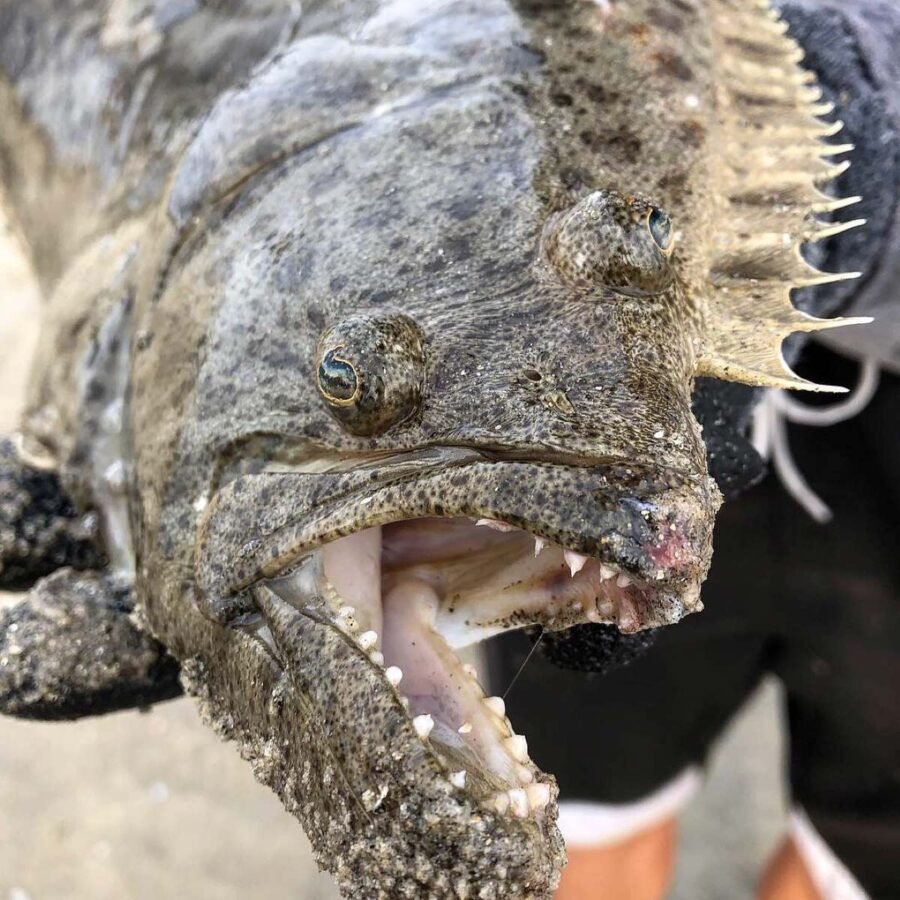
California halibut are one of the most sought after species to catch while shore fishing. They elude many and require time and knowledge to catch with consistency. This article will explain where to catch halibut from shore, the best baits and lures for halibut fishing, the best rigs for halibut fishing and the best rods and gear and tackle. We’ll also give you the rundown on the species and identification, habitat, range etc.
It’s also worth mentioning that of all the species to target while surf fishing in So Cal, halibut are one of the most challenging to catch with consistency and it may take you numerous attempts before you come out successful. Many anglers give up and turn back to light tackle Carolina rig fishing.
This article won’t make it “easy” to catch halibut, but it will give you the knowledge and confidence needed to learn how to catch halibut in the surf.
Table of Contents:
- California Halibut ID and Info
- Surf Fishing for Halibut
- Best Bait for Halibut Fishing
- Best Lures for Halibut Fishing
- Rods and Reels
- Where to Catch Halibut
- When to Fish for Halibut
- Gear and Tackle
- Tips and Tricks
California Halibut Identification and Information
Before we get into halibut fishing and what it takes to successfully catch halibut in the surf, here’s some general information about California halibut.
Halibut have a brown coloration intermixed with white and black spots on it’s top-side, while the underside is usually all white.
Halibut begin their lives as free-floating eggs and before surpassing their larvae stage, they have one eye on either side of their body. After about 1-month, the eye on the white side will have moved completely over to the top/dark side.
| Legal Limit (#) | (3) fish north of Point Sur, Monterey County, and (5) fish south of Point Sur, Monterey County |
| Legal Size (in) | 22-inches |
| Record Size (ft/lb) | 5-feet/72-pounds |
| Fighting Strength (-/10) | 8/10 |
| Range | Magdalena Bay, Baja California, to the Quillayute River, British Columbia |
| Habitat | Shallow/Sandy (nearby structure helps) |
California Halibut vs Pacific Halibut
Commonly confused with the Pacific halibut, the California halibut can be distinguished by a few characteristics. First, California halibut can actually be “right-eyed” or “left-eyed” while the Pacific halibut is always right-eyed.
This refers to the direction in which the fish’s head is pointed in relation to an “eyes-over-mouth” position. The picture below depicts a right-eyed halibut as the fish is pointed to the viewers right when the fish is “upright”.
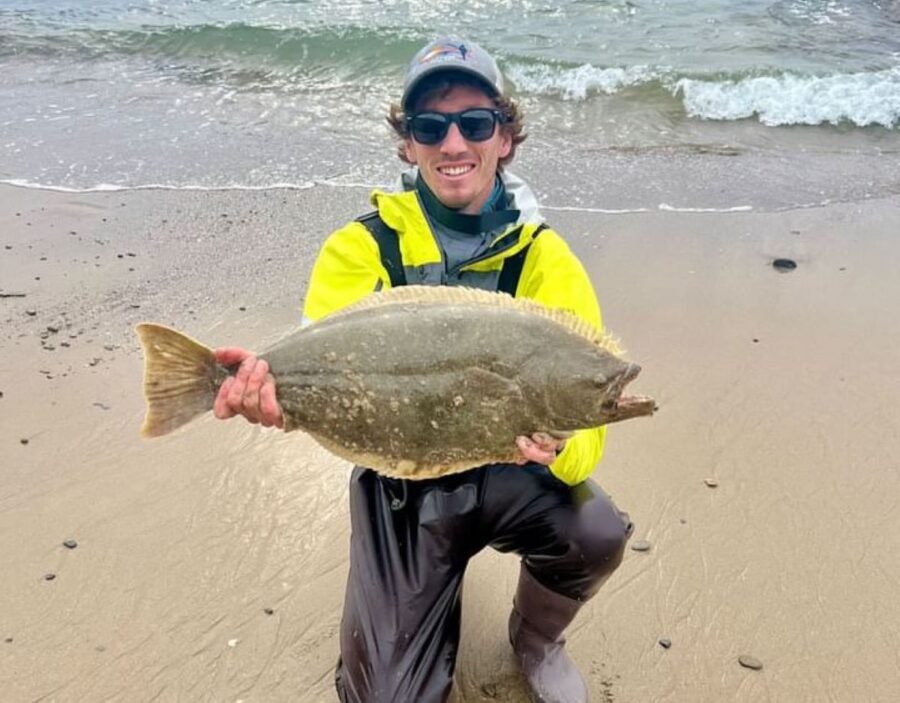
Second, the Pacific halibut usually has about 3 more dorsal “spines” than that of the California halibut. According to the California Department of fish and Wildlife, the California halibut usually has fewer than 77 while the Pacific halibut can have more than 80.
| California Halibut | Pacific Halibut | |
| Max Length | 70-pounds | 8-feet |
| Max Weight | 5-feet | 500-pounds |
| Depth | Surf Zone – 100-feet | Around 600-feet |
| Range | Magdalena Bay, Baja California, to the Quillayute River, British Columbia | Santa Barbara, California, to Nome, Alaska |
| Eyes | Right and Left | Always Right |
How Big Do Halibut Get?
While California halibut usually cap off at around 30-pounds, they’re said to be capable of growing to 5-feet long, weighing just over 70-lbs, and living some 30-years! More impressive is the Pacific halibut. It frequently surpasses 100-pounds and the 5-foot mark is considered average. They can reach lengths of up to 8-feet and grow to nearly 500-pounds.
Surf Fishing for Halibut
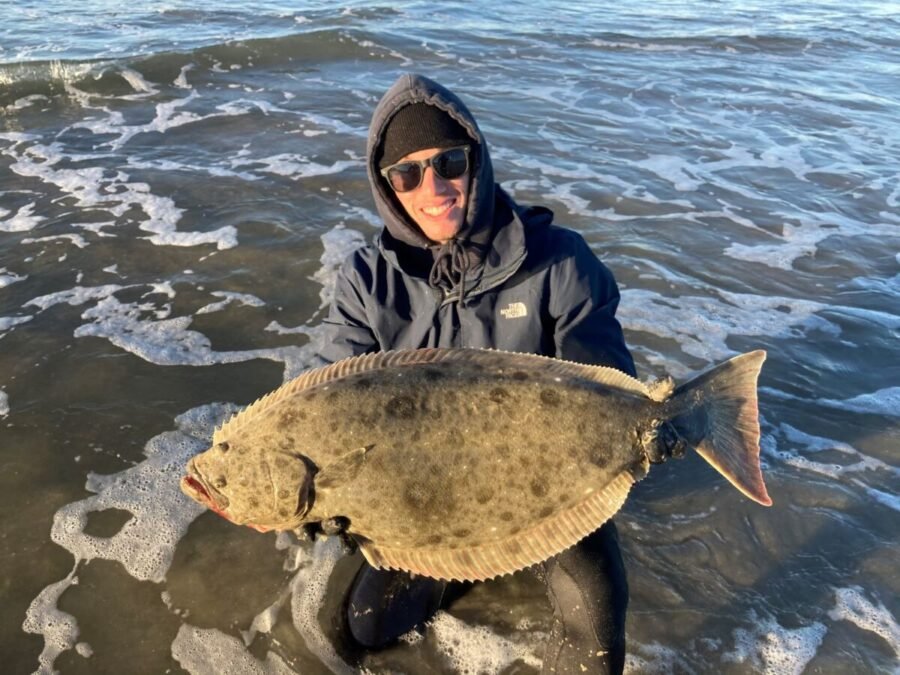
Alright, so now that we got the general info down, let’s talk about surf fishing for halibut.
To have success targeting halibut in the surf, you need to at least know the answer to the following two questions.
Where can you catch halibut? And what’s the best bait for halibut?
With all this information explained in detail, you’ll be able to piece the criteria together and discover the best beaches to catch halibut near you.
Best Bait For Halibut Fishing
There are two main method of targeting halibut from shore.
First is fishing with lures. This is more practical as it’s a very easy to access “bait” option.
The next is surf fishing with bait. The best bait for halibut is live bait like grunion and sardine and anchovy. But, these are tough to come by when fishing from shore. Let’s start with bait and we’ll then talk about lures.
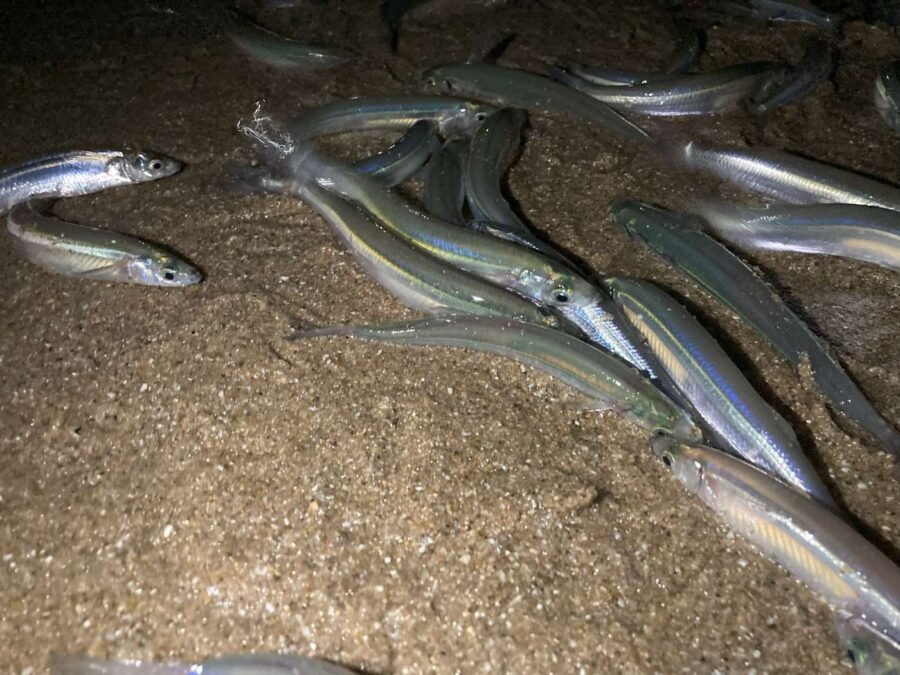
Using Live Bait for Halibut Fishing
Live bait will always be the most productive form of fishing (in my opinion) as you don’t need to trick the fish. You’re pretty much trading the fish a meal for a fight. This is much more commonly utilized when fishing from boats and even kayaks after catching bait fish with a Sabiki rig.
There is one really unique opportunity that we as So Cal anglers have that many other surf fishermen don’t have. Grunion runs! When they’re in season, I strongly recommend fishing with grunion during a run as they are perfect halibut bait. Here’s a really good resource on grunion runs. I detail when and where to go, including what characteristics to look for in beaches and what tactics to use.
Frozen Bait
One more method of surf fishing for halibut is by using frozen bait such as Anchovy or Sardine. This has produced many legal halibut for myself and company and it’s about as easy as it gets. With frozen bait, we catch a wider variety of fish, but halibut are in that variety, and you don’t need to worry about losing $20 lures. You can get these at your local bait shop for 5 or 6 bucks, and a bag should last you two sessions.
Best Rig for Halibut Fishing from Shore
The best halibut rig is very dependent on what method you’re using. Here are four common rigs and when you’d use each.
- Texas Rig – Swimbaits
- No Rig – Jerkbaits
- Dropshot – Fluke
- Carolina Rig
For more information on when to use which rig for all species in the surf, check out my article on the best rigs for surf fishing.
I like to use what’s called a stinger hook when fishing with frozen anchovies for 2 reasons. First, they fall off pretty easily if you cast to quickly. But, second, sometimes halibut will bite the back side of your bait. In that case, your stinger hook will do its job and make sure you don’t get robbed.
Best Lures For Halibut Fishing
When it comes to the best lures for halibut fishing, there isn’t really a “consensus” anymore. The Lucky Craft FM 110 used to have my vote, but then I found a better jerkbait (see in the linked article above) and I also began surf fishing with swimbaits.
Where the LC used to be everyone’s go-to, swimbaits now offer an incredible advantage to jerkbaits in that they can be fished weedless and snagless in rocky reefy structure. This type of structure is where you’ll have the best success halibut fishing from shore. Here’s an in depth break down I wrote comparing jerkbaits vs swimbaits for surf fishing.
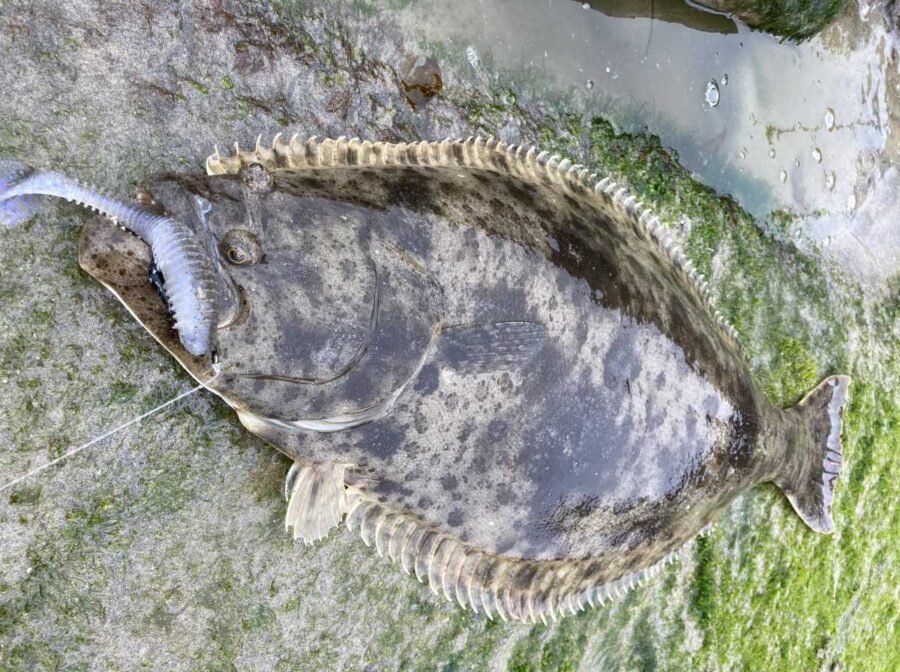
You’ll want to test out different retrieves and see what works best for you. For jerkbaits, I typically like a slow and steady retrieve. For swimbaits I like the same but I add some twitches here and there. Test out what works best for you though.
And again, fish those sandy flats in between or adjacent to rocky structure. I know it sucks losing expensive tackle, and it pains me to say it, but fish where you’d be scared you might lose your lure. It’ll pay off… no pun intended.
Try and get that lure right up against rocks and right between that 2-foot gap of reefy structure. I stand by this rule.
Best Rod and Reel for Halibut Fishing
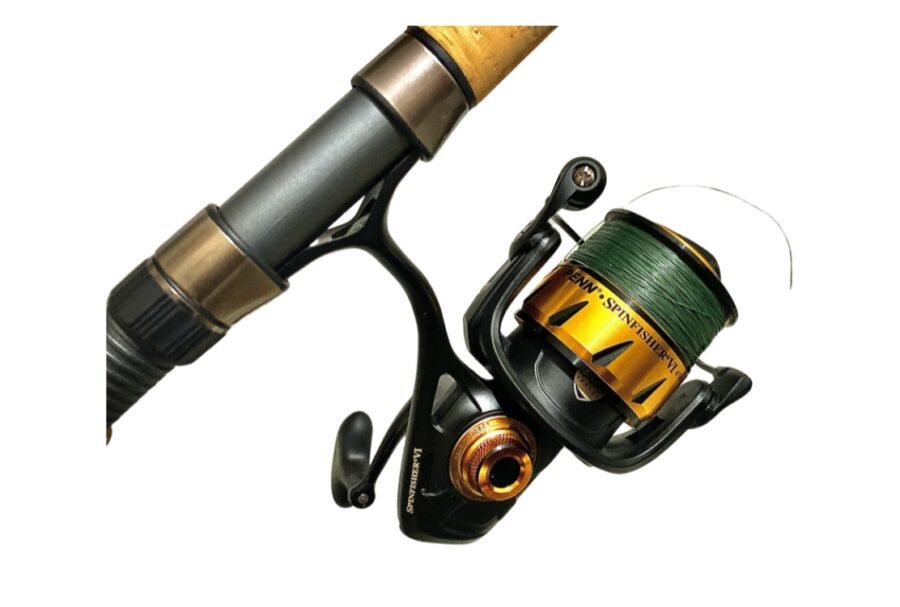
The best fishing rod for halibut fishing from shore depends on where you’re fishing and what you’re using for bait or lure. In general, the best rod for surf fishing for halibut is the Okuma SST. But, I have two different models of this same rod and use each with different lures.
Best Rod for Halibut Surf Fishing
For my main halibut fishing setup, I like the Okuma SST 9′ HA rod rated for 1/2 – 2 oz. This is for swimbaits (1/4 – 1 oz) while fishing heavy structure areas. If I’m using jerkbaits (5/8 – 3/4 oz) and fishing more sandy areas with less structure, I like the 8’6″ MHA version.
For an in-depth article on the best surf fishing rods and why I use each rod for each style of surf fishing, read the linked article.
Best Reel for Halibut Surf Fishing
As for the reel I like to use when targeting halibut from shore, I like the Penn Spinfisher VI 3500. I spool this with 30lb braided line and tie a 3 foot leader of 30lb fluorocarbon
There are some other options and if you’re interested, you can check out the linked article in the image above.
Where to Fish for Halibut
You’ll hear many different opinions on this and the fact is, you can catch halibut at many different types of beaches with varying structure. I’ve caught halibut on flat sandy beaches without any hard structure within miles. On the other hand, I’ve done the same at beaches with rocks and reefs near by too.
It’s tough when you get mixed information, and that’s one of the reasons why it took me so long to figure out halibut fishing. It’s true that you might end up catching a monster halibut in the middle of a flat sandy beach with nothing unique about it. Heck, you might even get on a killer bite too. But, there is a secret to having consistent success when surf fishing for halibut.
The Secret:
The secret is putting these concepts together. Halibut are an ambush predator. They’re also very flat and blend in with sand quite well as they have the ability to slightly alter their appearance in color. That being said, rocks and other structure in the water make for perfect ambush opportunities as halibut can further blend in and hide from their prey before attacking. But almost equally important, these structures actually draw in bait fish too. This is where everything comes together.
Find the structure… and the sand… together
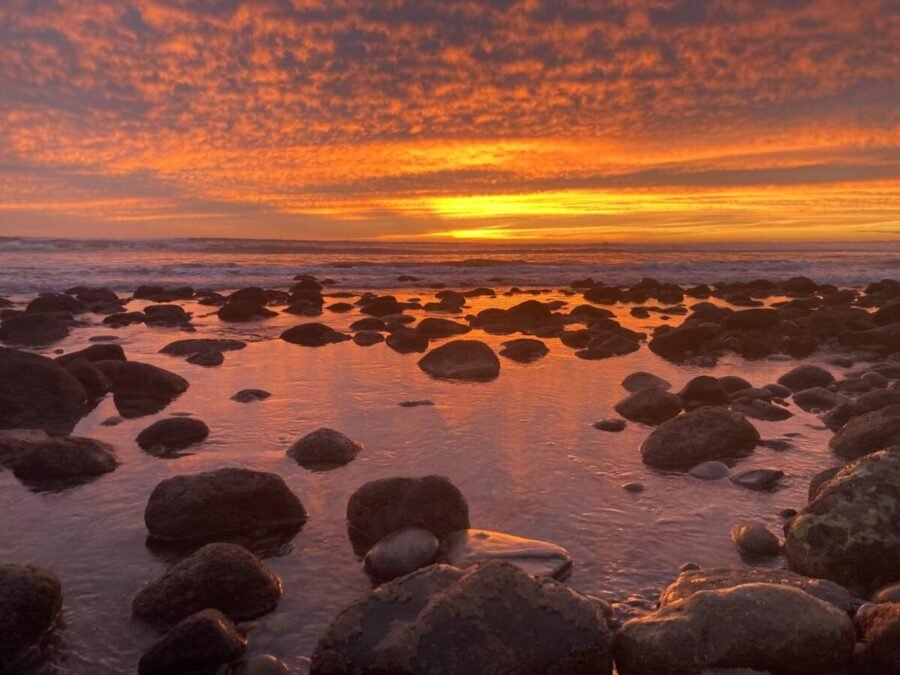
The best spots to catch halibut from shore are where sand meets structure. Halibut mainly prey on smaller bait fish like grunion, sardine, anchovy and other similar species. Structure like rocks, piers, reefs, and even jetties attract bait fish and provide perfect ambush opportunities.
Okay… so what about the flat sandy bottom? Halibut are flat and they usually sit on the sand or something else relatively flat so they can comfortably and easily blend in. For purposes of surf fishing, that something flat, almost 100% of the time, is sand, but can also be reef shelfs etc.
Where am I going with this? You need to find areas where there’s structure like rocks and reefs that are adjacent to, or have sandy flats within or around them. These are the ideal spots that have the potential to turn into honey-hole halibut fishing opportunities.
The image above is a prime example. There’s a lot of rocks in this zone, but there’s almost a pool where there are few rocks. A 30+ inch halibut could easily be preying on bait in this hole.
When to Go Halibut Fishing
Halibut, being one of the most coveted catches for light-tackle surf anglers across California, have an interesting “peak season”. The best time of year to go halibut fishing is pretty much year-round. In my experience, I’ve had the greatest success around spring. I’ve also had solid success in winter, but that may be because that’s when all other surf fishing is at its lull allowing me to take the time to fish for halibut. Either way, they can most definitely be caught year-round.
Best Tides for Halibut Fishing
Learn the tides and times for surf fishing that work best for the beaches that you frequently fish. For instance one of my favorite spots for halibut fishing has some really awesome structure, but its optimal water coverage is at a specific range of tidal height. Some people say that you should simply fish 2 hours before and 2 hours after a high tide and what not, but no. Put in the time, and figure out what tides hold the best opportunity for you. With the information listed above, this should be a breeze!
Low tides and specifically negative tides typically offer the best time to see the structure that halibut will hang out near. Use the low tides and especially the King Tides to hone in on the right zones for halibut fishing.
Gear and Tackle for Halibut Fishing
My Set-Up for Targeting Halibut with Swimbaits in Heavy Structure:
- Rod: Okuma SST-S-902HA – 1/2-2oz | 10-30lb | 9ft | H | MF
- Reel: Penn Spinfisher VI (3500 or 4500)
- Main Line: 30-pound braid
- Leader Line: 30-pound mono
- Lure Options:
- Lucky Craft FM 110 (jerkbait)
- Keitech Fat Swing Impact (4.8″) | Warbaits 0.5-ounce Weedless Jighead
- BioSpawn ExoSwim (4.75″) | Mustad KVD Grip Pin Swimbait Hook (5/0 | 1/8oz) (T Rigged)
My Set-Up For Targeting halibut with Jerkbaits:
- Rod: Okuma SST (8’6″ MHA)
- Reel: Penn Battle II or III 4000 series
- Main Line:
- Leader Line: 15-pound fluorocarbon
- Lures: Lucky Craft FM 110 and Shimano WM 115 SP
Halibut Fishing Tips and Tricks
There are always a couple tips or tricks that might help things click for an angler. Let’s talk about some tactics that help catch halibut.
Get a Feel For It
I’ve been asked by many people, “where do I catch halibut?” Many fishermen put in hours and hours before hooking their first halibut. You know that feeling when you’re fishing and that guy 10-feet from you is catching fish after fish, and you’ve got nothing? You’re not catching fish because you don’t have that knowledge and confidence and familiarity of where and when those fish will bite (at least for that given day at that given time).
Every angler goes through a period of time at the beginning of a session in which he/she has to feel out the nature of the day and of the bite-type. After you get those first couple bites, you start to dial it in. The same is true in the long-run. You need to feel the bite for yourself, have success on your own, and then everything will start to click for you.
Put In The Time
And just like everybody else says, put in the time! I was skunked many times using lures before I caught even just one fish on them. It took even longer to figure out swimbaits! But seriously, put in the time and take note of where and when you had success and during which conditions. If you’re fishing near structure, paying attention to the tides (and surf height/wind) just became the most important factor of targeting halibut for you.
Subscribe
If you enjoyed the read, be sure to enter your email in the box below and hit subscribe. You’ll be notified by email when my next surf fishing report or article is published. Tight Lines Guys!
There’s a really cool article referenced below about more on halibut fishing. The author noted a couple interesting points about what time of year you catch more halibut and what time of year you catch bigger halibut with the bigger halis being in winter. In my early experience, he was spot on. In recent years, I like spring a bit better. But either way, it might be valuable to read up on that article as well.
Click the link here. I found this resource really helpful.

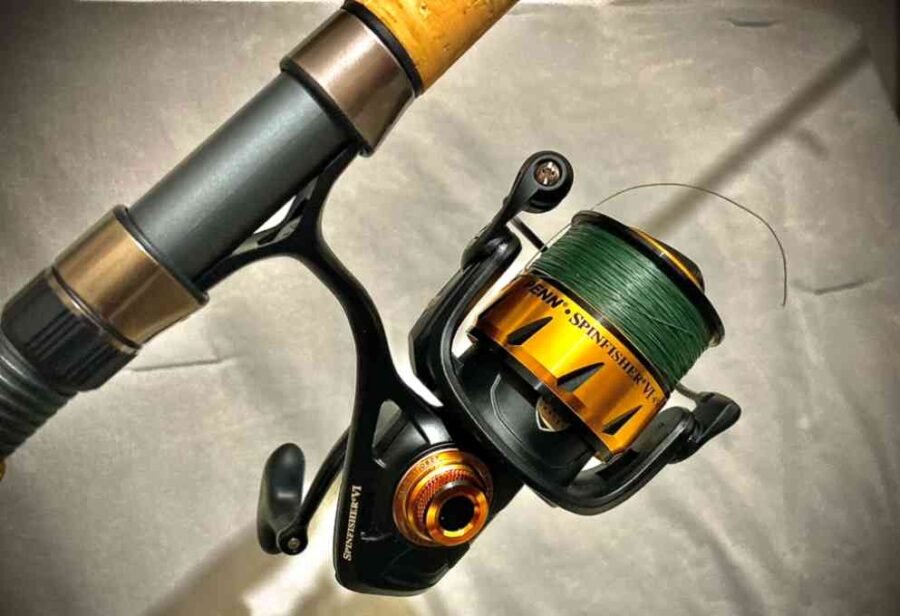
Geat Article! Thanks.
Thank you! I’m always looking to put quality information out there so if you have any questions or any intriguing topics, let me know. I’d be happy to research and write.
Good article, the only addition that might benefit readers, is learning to read troughs, bars, and holes in the surf. I find a lot of halibut on open sand, in a small eddy and seam running along a rip current.
Thanks for the input. I’ll go ahead and link an article about reading the surf in this comment. Appreciate your time!
Go to this link and scroll to the 4th section “Tips and Tricks”
http://surffishingsocalsd.com/
Thanks for the info. It’s a big help. I’ll try after the lockdown.
No problem. Best if luck out there whenever that may be.
I use all those techniques but I’ve caught more legals on a 5/8 ounce krocodile spoon
Thanks for the info! Any specific retrieve or you just try out which works best for the day?
Have had some good luck in Seal Beach with live smelt and fish trap lures.
Any experience catching small mackerel, sardines or smelt from Oceanside pier and using in the local surf? Also do you have a list of live bait sellers that welcome walk-ins?
I don’t have much experience catching live bait from piers but if I were doing that, I’d just use your classic sabiki. I’m sure the local surf critters would eat up live bait. That’s the same idea with grunion runs and I do have experience with that.
As for the list of walk-in bait shops I’m not sure but I know Dana landing has been open for walkin
I just started surf fishing again after a dozen years. I live in Oceanside haven’t had any luck in the past month. Thanks for the info hope it helps.
Awesome! Put the time in and I’m sure it will.
Am I rigging the lure like the Carolina rig, just the lure instead of the hook?
Thanks
No, the lure is just tied to the main line.
Do you use a weight above the lure on the main line? I caught (and released) a 10in Halibut a few weeks ago and used one of the LC lures on a Carolina rig :).. I put a piece of baitfish on the lure. But that was probably just a fluke. Wondering what you do usually? I find the LC lures kind of float around the top of the surf so I’m sure I’m missing a trick.
I tie the lure straight to my mainline. They are suspending lures but they should be about a foot underneath the water surface while retrieving. Seaweed can bring them right to the top so conditions need to be clean.
Thanks! Will try that next time. I have to say, your LC recommendations are spot on. The single halibut I’ve caught has been on an LC lure (I think it was metallic sardine) with a piece of baitfish attached to one of the treble hooks on it. Looking forward to a lot more!
Metallic Sardine is a good one! Never heard of attaching a piece of bait to one of the trebles though. That’s interesting.
Thanks for this and all of your great articles. I have learned a ton from reading them, and I am putting it to good use.
Just caught my 2nd legal halibut, as a result of all your help.
Heck Yes man! Thanks for letting me know and showing your appreciation.
Can’t believe I haven’t read this before, nice article Nick
I also found that glowing squid skirts on a dropper rig work well too. Mackerel on the hook helps a lot.
Way back in the 70’s I use to do a ton of surf fishing and jetty fishing at Seal Beach. In the mouth of the San Gabriel river, which is warmed by the power plant up river, Bonita would run. I use to use frozen anchovies, using a two hook method, stinger hook as you called it. One hook through the eye socket and then another in the tail. With no weight I would fly line the bait out and literally get worn out catching Bonita. I’m retired now and contemplating returning to the sport. Love to eat halibut, but love to fish too.
These days I usually do my fishing in the Sierra’s, cannot always go there, so a return to surf!
Thank you for an informative article.
Hi Nick,
Thank you for this website! I’m new to surf fishing and have had some great success following exactly what say on your different articles. Am I right that you use 15 lb mono with no leader when targeting halibut with lucky crafts and/or swimbaits? I’m weary of those sharp teeth breaking me off. I saw somewhere else you talked about using 30 lb braid?
Hey Nicky, thanks so much for the kind words. You’re touching on an area where I totally see why you’re confused. So, I will flip flop back and forth between straight 15-pound mono and straight 20 or 30 pound braid when I’m throwing a jerkbait in an area that I know mostly/only holds halibut and surfperch.
When I’m deliberately targeting halibut, white seabass, and calico etc. in a reefy, rocky area, I stick with 30-pound braid and a 30 pound mono or fluorocarbon leader. I apologize for how confusing it might all seem on the website as part of it is that I juts do a few different things for different scenarios and part of it is that I don’t always get around to updating old info in real time. Hope this helps!
Thank you for the response! Makes perfect sense.
read a ton of your blog the last few days before traveling here and snagged a just under keeper halibut on silver strand in my second hour out with a (7’6″) shorter rod but similar setup overall, on a knockoff LC 110 from walmart. thank you so much for all the time and effort into the website.
Very nice! Always glad to hear about your guys’ success.
I took all of your great advice, and landed 2 25″ halibuts by 7:30 am in the surf at crystal pier, by lure with a Shimano 150 knock off with glow on 4/30/25. Thanks so much! It’s guys like you that give fisherman blogs a better rep.
Awesome to hear! Thanks for the kind words and support. Hope you have a killer year!